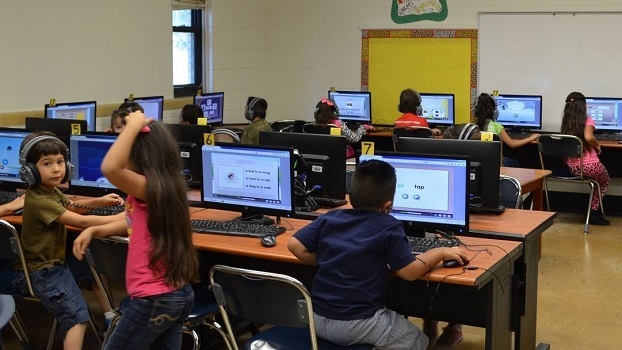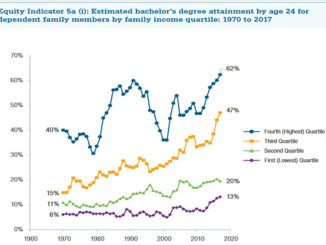
By Jessica Towhey, RCP
New Mexico Education Secretary Hanna Skandera spends a lot of time traveling the state, meeting educators and families, listening to their stories. On one occasion, she heard from a mother pleading not let her other children have the same experience as her eldest son. That son needed costly remedial tutoring throughout his first year of college because he was not academically prepared for the advanced coursework. And get this: He was his high school’s valedictorian.
“It should not matter what zip code you live in for how prepared you are for life,” Skandera said, acknowledging that New Mexico’s education system faces many challenges. Still, that isn’t discouraging her from moving ahead with ambitious goals under the Every Student Succeeds Act, the new federal law that returns a large chunk of education authority back to the states.
“People say maybe it’s not possible to have high expectations for all kids,” Skandera continued. “There are tough circumstances – poverty, English as a second language – but we have the same expectations no matter the beginnings. We are going to make diplomas meaningful. We are going to make sure [students] are successful in life.”
A confluence of factors – including falling natural gas prices, drought, declining tourism and a reduction in federal funds – have made New Mexico one of the poorest state in the nation. Census data indicates that the median household income in 2015 – the latest year available – was $45,382, a full $10,000 lower than the national average. Its unemployment rate in March 2017 was 6.7 percent, the highest in the nation. Talk Poverty’s 2015 report noted that fully 20 percent of New Mexican youths feel “disconnected” and more than 436,000 residents were living in poverty.
According to the National Assessment of Educational Progress, New Mexico consistently ranks among the lower achieving states. An annual report from the Education Week Research Center ranked the state 49th in the nation overall and last in the “Chance for Success” category.
“Obviously, there’s a lot of room for improvement,” said Sterling Lloyd, the senior research associate for the Editorial Projects in Education Research Center. “No one’s found the magic bullet, and there’s not a best-practice manual out there. Everyone’s trying to figure out how to boost the scores, but they’re not responsive to any one set of measures or reforms. It’s hard work.”
Overcoming Ingrained Challenges, Hard Work Paying Off
Hard work – that’s what Skandera is confident New Mexico’s students and educators are up for. Indeed, over the last few years, students have made “unprecedented progress” on statewide assessments in math, science and English-Language Arts, according to an update from the Public Education Department (PED) posted in October. Of the 89 school districts, 77 saw improved math scores and there are 5,000 more “students proficient in reading” than before that year’s assessment.
Graduation rates, an area specifically called out for improvement in the state’s ESSA plan, are up by 5.6 percent since 2011. That growth is better than the national average.
“We have a lot of work to do compared to other states,” Skandera said. “We believe with states being empowered as they are with the ESSA law, it is our responsibility and an opportunity to really rise to the challenges and lead.”
Six years ago, New Mexico implemented new, higher-quality academic standards that were more rigorous than previous benchmarks. It also adopted new statewide assessments that are aligned to those standards so that students would be tested on what they learned instead of what they should be expected to know. That difference lets state education agencies better measure student learning and also see how schools are performing. Those efforts have built a solid foundation for New Mexico to begin using the flexibility in ESSA to make improvements.
“We made the commitment to high standards for students and educators,” Skandera stated. “We already did a lot of that hard work. We’re in a place now where we’re not only seeing real progress but we can set those aggressive goals and measure how students are doing.”
Separate from ESSA, New Mexico’s higher education institutions want to see 60 percent of working-age New Mexicans earning a college degree or post-secondary education credential by 2030. Working backwards from that goal, the Public Education Department determined that aggressive benchmarks were needed to make that happen. These aggressive goals include getting 50 percent of students performing on grade level in math and reading by 2020 and significantly reducing the number of students requiring remedial education their first year in college.
In a state that has spent much of its time in the lower echelon of education rankings, that really shook things up.
“There is a lower-income mentality that we’re dealing with,” said Terri Damron, an elementary school teacher in a district near the Texas border. “They’re not very motivated, and [students] don’t have parents who are encouraging them. They’re not going to try to meet expectation because they’re just going to stay in the system.”
But Damron is among a group of educators working closely with the Public Education Department to change that. She sits on the Secretary’s Teacher Advisory Council that is part of the state’s Teacher Leader Network. The network helps build and strengthen the lines of communications between state decision makers and educators, many of whom have grown displeased over the years with the education department’s outreach and directives. The council will hold its second annual summit next month. Damron said the first was inspiring.
“The PED is building trust with teachers, similar to how teachers build trust with our students,” she remarked. “Students don’t like being pushed, and I believe teachers are the same way. Some have the attitude that they’ve just been told what to do by an administration and there’s never been a relationship there.”
Damron believes there’s been a positive response from teachers who are beginning to see state officials as partners in setting ambitious goals.
Teacher’s Union Gives Skandera Failing Grades
However, not everyone is onboard with the game plan.
The American Federation of Teachers’ (AFT) New Mexico chapter is among Skandera’s staunchest foes. The labor union won a court injunction against using standardized test scores in teacher evaluations. It opposed merit pay for teachers and Skandera’s system for using letter grades in school accountability. AFT New Mexico State President Stephanie Ly said the high-stakes goals that would be in place under ESSA will make students “disinterested” in education.
“If you look at the policies she’s trying to push, they’re all blaming the schools, the communities, educators,” Ly said. “We were very excited about ESSA. It’s a chance to move from high stakes, negative, punitive policies the Secretary is pushing. We need to have an honest discussion about the fact that her policies are not working.”
With the State Legislature coming back for a special session to look at education funding, Ly said that is an opportunity to work with lawmakers to combat Skandera’s plans. If that doesn’t work, Ly said the union is looking forward to the 2018 election when a new governor would appoint a more acceptable education secretary.
“We do not have high hopes for the ESSA plan,” Ly stated. “It will be our jobs to continue working with school districts to make sure the high-stakes, negative policies don’t become a serious reality for students.”
High Expectations for the Lowest Performances Can Lead to Greater Progress
Criticism from teachers’ unions notwithstanding, there growing evidence that high expectations in New Mexico can lead to better student outcomes.
McKinley County is one of the poorest counties in the state, which means that it’s also one of the poorest counties in the country. It sits near New Mexico’s northern border with Arizona. There are roughly 75,000 residents and 77.5 percent are Native American. Census data notes that 73 percent of people living there graduated from high school and only 11 percent hold a Bachelor’s degree. The median household income is $28,000 – well below the state’s average. The average income per capita is about $12,000, and 34 percent of the county is living in poverty. Part of the sprawling Navajo Indian Reservation runs through the county, as well as the Zuni Indian Reservation.
Statistics and research say that those components should add up to underachieving schools and low performing schools. But the reality is much different.
In the 2013-14 school year, the Gallup-McKinley County Schools had 11 schools that received a grade of F, as in failing. In 2015-16, there were zero failing schools. Critics would be wrong to suppose the district changed how it measures schools. The formulas are done by the state and based on five criteria, including standardized test scores, the growth of high- and low-performing students, and a survey of parents or guardians regarding whether the school presents an opportunity for students to learn. The individual breakdowns are impressive:
2013-14, zero A schools; 2015-16, 2 A schools.
2013-14, two B schools; 2015-16, nine B schools.
2013-14, 10 C schools; 2015-16, 17 C schools.
2013-14, 12 D schools; 2015-15, seven D schools.
The improvement in student performance is equally impressive. From 2014-15 to 2015-16, there were 509 more students who earned a ranking of proficient in math and English-Language Arts on statewide tests. Nearly 95 percent of those students are economically disadvantaged. And 76 percent of the 509 were Native American, whose historical performance on assessments is underwhelming.
So what has Gallup-McKinley figured out that other struggling districts haven’t?
“These are not accidents,” Associate Superintendent Gerald Horacek said. “We believe in a system-wide approach at the district level that’s sustainable. You use strategies that are best for kids, and it doesn’t matter their ethnicity. We get caught up a lot in that. You just have to have good teaching.”
You might also add good data. Gallup-McKinley students sit for district-level assessments every nine weeks. Known as interims, these tests regularly and methodically assess how well students have learned what they have been taught. When the results are in, students get a day off while educators and district officials sift through the results to study shortcomings that can be immediately corrected and strengths that can be built upon. Horacek noted that every question on the interim relates directly to what has been taught in the classroom.
“That’s why we’re able to move school grades and the number of students who are proficient,” Horacek said.
The district is still among the lower performers in the state, something officials there acknowledge. “We have a ton of things we have to work on,” Horacek admitted. They have more than doubled growth rate on statewide scores – an early indicator of sustainable success – but still score almost 10 points lower than the state average on overall student proficiency. Still, Horacek said, “We’re doing something well to help our struggling kids get better.”
That’s the ultimate goal – help struggling students succeed and make sure high-performing students remain challenged.
Skandera expects that the work that’s already been done to raise expectations, coupled with the aggressive goals in the ESSA plan, will mold confident students who are eager for success. No matter the pushback from unions or other naysayers, she is committed to seeing it through.
“We’ve had generations of struggle in regard to the outcomes in education,” she said. “We’re making progress, but we have a lot of work to do. Every generation, every year that goes by, they’re either set up for success or they’re not. They cannot wait. We need to set aside petty differences and remember who we serve. The future of New Mexico depends on our kids.”
Jessica Towhey is Education Policy analyst for RCP.



